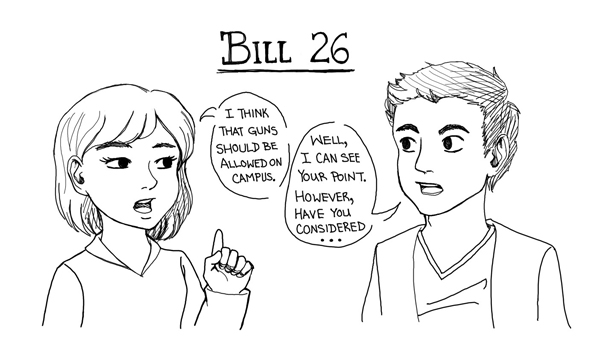As the fight over gun control legislation continues, many political activists on the left have sought to put forward strict controls on firearms. Senator Dianne Feinstein recently proposed a new, more robust assault weapons ban, and the state of New York passed one of the most restrictive gun control laws in the nation just a few weeks ago.
In response, many conservative legislatures and lawmakers have begun proposing legislation that seeks to do the exact opposite – instead of restricting gun ownership, they have sought to remove or loosen some gun restrictions. The recently proposed H.B. 29 bill, which would permit concealed carry on both private and public college campuses in Georgia, is one such effort. Many critics have come out in opposition to this bill. Here at Emory, College junior Ben Leiner penned a very forceful piece on the subject on Tuesday. Citing Representative Charles Gregory’s (R-Kennesaw) comments that if the principal at Sandy Hook or another school authority figure had carried a firearm that day, then the school shooting might not have happened, he decried the Republican legislator’s position as irresponsible: “Instead of proposing legislation to prevent massacres from happening, such as testing for mental illness before selling firearms, treating the mentally ill or, God forbid, an assault weapons ban, Mr. Gregory has introduced a resolution to start an arms race fueled by fear.”
With all due respect to Mr. Leiner, his argument was incredibly poor. He misappropriated Representative Gregory’s comments in order to launch an anti-gun tirade that was almost purely built around common gun misconceptions and popular talking points.
His argument that the police should be good enough as a deterrent against crime is one example: had he briefly researched the issue, he would have discovered that the average response time after calling 9-1-1 in Atlanta was over 11 minutes in 2010. Many other cities nationally average between four and nine minutes.
When most violent crimes only take one or two minutes, it’s clear that individuals can still reasonably claim to need other means of personal self-defense beyond simply waiting on the police. In my Jan. 18 Wheel column, “Thinking Through A Gun Ban,” I commented that our culturally-inspired responses to guns – as we see them in extreme situations on TV, film and in games – generally provoke us into thinking emotionally about guns and gun laws rather than rationally. This applies to both pro-gun and anti-gun individuals, and in both cases, an individual can respond in ways that are far from constructive.
If we are going to have a rational discussion about guns and gun laws – here, concealed carry laws – emotionally-loaded arguments like those deployed by Mr. Leiner are either unhelpful at best or destructive to dialogue at worst. So, let’s start this discussion over: what do we actually know about concealed carry laws? According to one landmark study conducted by economists John Lott, Jr. and David B. Mustard in 1997, the implementation of concealed carry laws in a county resulted in a 7.65 percent drop in murder rates, a five percent reduction in rape rates and a seven percent decrease in the rate of aggravated assault.
Further, that same study found that only 24 percent of people surveyed who had used a concealed carry weapon in self defense actually had to fire their gun and only eight percent actually wounded the assailant.
While the study was controversial when it was first released, other scholars who have replicated the research using additional data and newer techniques have come to the same conclusions. Some have found that Lott and Mustard’s original estimates may actually have been too low, and that concealed carry laws actually had a larger effect on reduced violent crime rates than originally estimated.
Well, what does that mean?
Essentially, concealed carry laws do not act as a catalyst for more violence as some critics (including Mr. Leiner) claim.
Conversely, they actually do reduce violent crime rates – and in a combined 92 percent of cases, simply pulling the gun out or firing a warning shot is all that is needed to halt a crime in progress. Historically, we can also see numerous examples where off-duty police officers and private citizens who were carrying concealed firearms were able to avert or stop crimes in progress.
In the week after Sandy Hook, an off-duty police officer shot a man who had begun firing into a movie theater in San Antonio, Texas. Everyone lived. In Winnemucca, Nev. in 2008, a concealed carry permit-holder shot and killed a man who had begun firing into a crowded restaurant. Only two people were killed. At the Appalachian School of Law in 2002, two armed students pointed their guns at a campus shooter, distracting him and allowing a third student to tackle him. Only three people were killed.
I personally think that H.B. 26 is being promoted more out of a reaction to perceived threats to American gun rights rather than out of an interest in good policy. For that reason, I am undecided as to whether or not I support the bill. However, that doesn’t change the fact that concealed-carry laws do have beneficial effects demonstrated by historical and statistical evidence.
Instead of decrying promoters of concealed-carry as extremists who want to destroy the peaceful fabric of our campus or of society at large, we can and should instead have a rational discussion. Reverting into either ideological camp and entrenching our positions does nothing but hamper our ability to work together to actually reduce violence in society.
David Giffin is a second-year Masters in Theological Studies student at the Candler School of Theology from Charleston, Ill.
The Emory Wheel was founded in 1919 and is currently the only independent, student-run newspaper of Emory University. The Wheel publishes weekly on Wednesdays during the academic year, except during University holidays and scheduled publication intermissions.
The Wheel is financially and editorially independent from the University. All of its content is generated by the Wheel’s more than 100 student staff members and contributing writers, and its printing costs are covered by profits from self-generated advertising sales.





